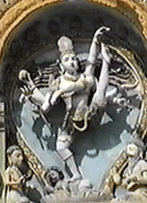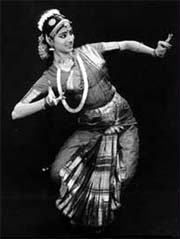Apr 16, 2025
Apr 16, 2025
 Dance in India (like all other traditions and beliefs) has a mythological beginning as well. Centuries ago when the world was steeped in anger and jealousy, greed and desire, pleasure and pain the people went to Brahma to seek an end to this misery. It is said that Brahma created the Natya Veda, the fifth scripture to save humanity from deterioration from moral values. He created this Veda by taking elements from the other four Vedas. He took Speech from the Rig-Veda, Abhinaya(the entire gamut of speech, body, dress and facial expressions) from the Yajur Veda, music from the Sama Veda and aesthetic experiences from the Atharva Veda. He revealed this Veda to Sage Bharata. The Sage went to Lord Shiva to learn and add dance movements to the drama he had created according to the Veda. And thus dance and drama were created. Sage Bharata's Natya Shastra is the most exhaustive text on theatre art. It is the easily the oldest in the world and is the common basis for the Indian classical tradition of music, dance, drama and iconography.
Dance in India (like all other traditions and beliefs) has a mythological beginning as well. Centuries ago when the world was steeped in anger and jealousy, greed and desire, pleasure and pain the people went to Brahma to seek an end to this misery. It is said that Brahma created the Natya Veda, the fifth scripture to save humanity from deterioration from moral values. He created this Veda by taking elements from the other four Vedas. He took Speech from the Rig-Veda, Abhinaya(the entire gamut of speech, body, dress and facial expressions) from the Yajur Veda, music from the Sama Veda and aesthetic experiences from the Atharva Veda. He revealed this Veda to Sage Bharata. The Sage went to Lord Shiva to learn and add dance movements to the drama he had created according to the Veda. And thus dance and drama were created. Sage Bharata's Natya Shastra is the most exhaustive text on theatre art. It is the easily the oldest in the world and is the common basis for the Indian classical tradition of music, dance, drama and iconography.
Shiva, the Lord of dance is said to have created the Universe with his Ananda Tandavam, or the dance of joy. It is He we see dancing in the rise and the fall of the waves in the oceans, in the volcanoes and the earthquakes, in the rotation of the planets and the stars. In the lighting and the thunder. All movements within this cosmos is said to be His dance.
Apart from these divine beginnings of dance, we have evidence to show that classical dance in India is at least 2000 years old. Various cave paintings, engravings, sculptures from the Mohenjo Daro civilization and other literary works show the beginnings of a very ancient dance form. The numerous sculptures in the different temples of India (from Kashmir to Kanyakumari) show that dance was a rich and vibrant dance form even in the early AD'S.
 The different classical dance styles were practiced and perfected in the different parts of the country even through social and political upheavals. Family traditions grew within styles. In most places dance was performed in the temples as the highest form of worship to God. They were danced by young girls called Devadasis (servants of God) who were dedicated to a particular temple and a particular God. It was a sacred art form. Unfortunately, the British rulers did not see the arts as a form of education or moral tradition and started to alienate it from the people. They put a ban on temple dance and slowly the art started to die. Apparently by the 20th century we were left with only a shadow of what had been and existed.
The different classical dance styles were practiced and perfected in the different parts of the country even through social and political upheavals. Family traditions grew within styles. In most places dance was performed in the temples as the highest form of worship to God. They were danced by young girls called Devadasis (servants of God) who were dedicated to a particular temple and a particular God. It was a sacred art form. Unfortunately, the British rulers did not see the arts as a form of education or moral tradition and started to alienate it from the people. They put a ban on temple dance and slowly the art started to die. Apparently by the 20th century we were left with only a shadow of what had been and existed.
A recent and renewed interest in our dance forms in the last 50 years or so has helped to develop the current styles. A lot of the glories of the past traditions have been uncovered. The styles of today are the recreations of these discoveries. So they are ancient at the same time being contemporary. They are performed outside the traditional milieu but at the same time trying to recreate the past. New themes are infused within the technique of the old styles and sometimes the ancient themes are presented in a new form and technique.
Kathak from North India, Manipuri from the North Eastern corner, Odissi from Orissa, Kuchipudi from Andhra Pradesh, Bharatanatyam from Tamil Nadu and Kathakali and Mohiniattam from Kerala are some of the present day classical dance styles of India. The techniques of most of these forms can be traced back to the rules laid down in the Natya Shastra. Seeing the beauty, grace and the seemingly different styles of today one can only imagine how magnificent the dance of the bygone times would have been!
If political upheavals had threatened the art years ago, it is the idea of dance being a form of mere entertainment that is killing it today. A mere recreation of the ancient art in the physical plane is not enough. The declining audiences, the competition from popular cinema and TV and the influence of western culture only emphasizes the lost sacredness of the dance. Tracing through the centuries of Indian dance one can only see it as being sacred or devotional. The Gods themselves were supreme dancers. Sage Bharata has noted in his colossal work that "Natya teaches duty to those who go against it, love to those who desire it, chastises those who are ill-bred or unruly, promotes self restraint in those who are undisciplined, gives courage to the cowards, enthusiasm to the valorous, enlightenment to those of poor intellect and gives wisdom to the learned. It gives diversion to the kings, solace to those with a sorrowful mind, wealth to those desirous of it and composure to a mind of conflicts."
Dance is a sacred movement of the various limbs with deep divine feeling. The songs are purely devotional love songs with the dancer being the devotee and God being her beloved. The heroine longing for her lover is not a male chauvinistic theme as considered today but is the Jeevatma (Individual Self) longing for the union with the Paramatma (Divine Self). When the dancer believes in this, she not only transports herself to a higher plane of consciousness but also takes her audience with her. Her audience walks out of the performance feeling exactly like what Sage Bharata said!!!
Today when moral values are declining and violence is increasing, it is the duty of the dancer to create an atmosphere of peace through her dance and the deep spiritual dedication that accompanies any performer of the classical dance style. After all, Brahma created this audio-visual art form to check the moral deterioration in the world.
Shreelata Suresh, an exponent of the Bharatanatyam and Kuchipudi styles of dance, is one of the leading dancers today. Apart from performing regularly, she also teaches dance in her school, Vishwa Shanti, promoting peace through dance and allied arts, in San Mateo, California. She is a practitioner of Yoga, an avid gardener and a mother of an active two year old.
10-Mar-2001
More by : Shreelata Suresh